Can You Add Backend Tech to Webflow Overview
In this modern digital age, having a professional and user-friendly website is crucial for any small business looking to attract customers and generate leads. However, hiring a professional web designer can be costly, especially for small businesses with limited budgets. This is where website builders come in handy. Website builders are tools that allow users to create websites without any coding or technical skills. There are many options available, but finding the best free website builder for small businesses can be a daunting task. To help you make an informed decision, we have compiled a list of the top free website builders for small businesses.
Webflow is a powerful tool that allows designers and developers to create stunning websites without having to write a single line of code. It offers a simple drag-and-drop interface that makes it easy to build responsive websites quickly and efficiently. However, one limitation of Webflow is that it does not natively support backend technology. This means that if you want to add dynamic functionality to your site, such as user authentication, data storage, or custom forms, you will need to use external services or tools.
In this article, we will explore how you can add backend technology to your Webflow site and some of the options available for integrating backend functionality with your Webflow project.
One popular option for adding backend technology to a Webflow site is to use a third-party service like Zapier or Integromat. These platforms allow you to automate tasks and connect different apps and services together without writing any code. With Zapier or Integromat, you can create custom workflows that trigger actions based on events that occur on your Webflow site, such as submitting a form or clicking a button.
For example, let’s say you want to add a contact form to your Webflow site and have the form submissions saved to a Google Sheet. With Zapier, you can create a workflow that triggers when the form is submitted and automatically adds the form data to a Google Sheet. This allows you to collect and organize the form submissions without having to manually enter them into a spreadsheet.
Another option for adding backend technology to a Webflow site is to use a headless CMS (Content Management System). A headless CMS separates the content management backend from the frontend presentation layer, allowing you to manage the content of your site through a separate system. This can be a powerful way to add dynamic content to your Webflow site without compromising on design and usability.
One popular headless CMS option is Contentful. With Contentful, you can create and manage content in a structured way and then retrieve it using an API. This allows you to populate your Webflow site with dynamic content from Contentful without having to manually update the site each time new content is added or changed.
Another option for adding backend technology to a Webflow site is to use a custom backend server. This option requires more technical knowledge and coding skills but allows for greater flexibility and control over the backend functionality of your site. You can use a backend server to handle user authentication, data storage, and other complex tasks that require server-side processing.
To integrate a custom backend server with your Webflow site, you can use APIs to send and receive data between the frontend and backend. You can use tools like Express.js or Node.js to create a RESTful API that communicates with your Webflow site. This allows you to add dynamic functionality to your site, such as user authentication, data storage, and custom forms.
In conclusion, while Webflow does not natively support backend technology, there are several options available for adding dynamic functionality to your site. Whether you choose to use a third-party service like Zapier or Integromat, a headless CMS like Contentful, or a custom backend server, you can enhance your Webflow site with backend technology to create a more engaging and interactive user experience. With the right tools and approach, you can take advantage of Webflow’s design capabilities while adding powerful backend functionality to your site.
In conclusion, building a professional-looking website doesn’t have to break the bank. There are plenty of affordable website builders available that offer a wide range of features at budget-friendly prices. Whether you’re a blogger, small business owner, or artist, there’s a website builder out there that can help you create a beautiful and functional website without spending a fortune. With the options mentioned in this article, you can find the cheapest website builder that suits your needs and budget.


